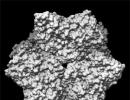How to make a helium balloon. how to inflate a balloon with baking soda and vinegar how to inflate a balloon with baking soda
In this wonderful experience, we will show you how to inflate a balloon with baking soda and vinegar. At first glance it sounds strange and unusual, but in fact everything is quite simple.
This experiment clearly shows what a simple chemical reaction can lead to.
After the experience, we will tell you why the balloon inflates and what happens when we mix soda with vinegar.
For the experiment we need:
- small empty bottle
- baking soda
- vinegar
- balloon
First, pour baking soda into the ball. For convenience, we used a funnel, but you can pour soda, for example, with a teaspoon. You can pour about three to four teaspoons.

Pour some vinegar into the bottle.

Next, take the ball and put it on the neck of the bottle. Put the balloon on so that the soda remains inside the balloon and does not fall into the bottle. Then sharply straighten the ball so that the soda spills into the bottle. As soon as this happens, a chemical reaction will begin inside the bottle. You should see the vinegar begin to gurgle and foam as the balloon begins to inflate.

We didn't use a lot of baking soda and vinegar, so the balloon didn't inflate too much.

Do you want the balloon to inflate faster and better? Before the experiment, inflate it by yourself once with your mouth, and then deflate it to stretch the material.
Explanation of experience
Everything that surrounds us consists of molecules or various types of substances. Very often, two kinds of molecules interact with each other to form new molecules. In our experience, the interaction of soda and vinegar occurs.
Baking soda is sodium bicarbonate molecules. Baking soda is a type of substance called basic.
Vinegar is a mixture of acetic acid and water. Acetic acid is a type of substance called acid.
It is acetic acid that reacts with soda. This reaction is called neutralization, since as a result we do not get either the base substance or the acid.
As a result of a chemical reaction, we get new substances: water, a type of salt and carbon dioxide (carbon dioxide).
The carbon dioxide leaves the liquid mixture, expands inside the bottle and balloon, and inflates the balloon.
We conduct many experiments and experiments in the kitchen, using what is in the kitchen cabinets. Got some vinegar today. I bring to your attention experiences with vinegar which made us very happy.
With vinegar:
- inflate a balloon;
- make a volcano
- dissolve the shell;
- Let's make a rubber egg.
Volcano in a bottle
Using the reaction of the interaction of soda and vinegar, we created a volcano in a bottle.
For experiments used:

rubber egg
With the help of vinegar, a chicken egg, and  if desired, and quail, can be turned into "rubber". Vinegar reacts not only with soda, but also with many other substances, one of them is calcium. The egg shell contains calcium.
if desired, and quail, can be turned into "rubber". Vinegar reacts not only with soda, but also with many other substances, one of them is calcium. The egg shell contains calcium.
To observe the interaction reaction, place the egg in a glass of vinegar. We used 9% vinegar. Already after 12 hours, the egg has changed, it has lost its hard shell. From the glass we took out a chicken egg that can jump like a ball. But not  overdo it! Our experimental egg jumped, jumped and burst right on the carpet in the room. Of course, the egg does not turn into rubber, just under the influence of acid the shell dissolves, and the protein and yolk remain “wrapped” in a thin film that existed before, but was not visible. An egg without a shell glows very beautifully if you direct a flashlight beam at it.
overdo it! Our experimental egg jumped, jumped and burst right on the carpet in the room. Of course, the egg does not turn into rubber, just under the influence of acid the shell dissolves, and the protein and yolk remain “wrapped” in a thin film that existed before, but was not visible. An egg without a shell glows very beautifully if you direct a flashlight beam at it.
After experimenting with the egg, we thought, what else can be dissolved in vinegar?
Dissolving the shell 
Grandmother from the sea brought us beautiful shells. We decided to donate one of them to study its solubility. We read that shells were composed primarily of calcium carbonate and assumed that the calcium would react with the vinegar and our shell would dissolve. Checked experimentally. They immersed the shell in vinegar, but there were no significant changes during the day. Do you think we are disappointed? Not! Once in Vinegar  does not dissolve, so the concentration of acid is too small. The shell was soaked in 70% acetic acid. In 18 hours, the shell thinned significantly, and after 48 hours it completely melted.
does not dissolve, so the concentration of acid is too small. The shell was soaked in 70% acetic acid. In 18 hours, the shell thinned significantly, and after 48 hours it completely melted.
With acetic acid, you need to be extremely careful!
Our dissolving moods did not end there. A piece of chalk came into view. Here he is  probably great to dissolve! It turned out that we were wrong. Having immersed a school chalk in a glass of vinegar, we observed a beautiful gas evolution reaction, small bubbles enveloped the chalk. But the reaction quickly ended, disappointing us. As we later learned, gypsum is added to school crayons, but it does not dissolve in vinegar.
probably great to dissolve! It turned out that we were wrong. Having immersed a school chalk in a glass of vinegar, we observed a beautiful gas evolution reaction, small bubbles enveloped the chalk. But the reaction quickly ended, disappointing us. As we later learned, gypsum is added to school crayons, but it does not dissolve in vinegar.
Inflate a balloon with vinegar and baking soda
Everyone who loves baking knows that when baking soda and vinegar interact, carbon dioxide is released. Using this knowledge, you can inflate a balloon.
For this we need:
- plastic bottle,
- vinegar,
- soda,
- ball,
- funnel.
Pour about 100-150 ml of vinegar into the bottle. Pour 1 tablespoon of baking soda into an uninflated balloon. It is easier to do this using a plastic funnel or make a paper funnel. Next, we put the ball on the neck of the bottle and straighten it. Soda begins to spill into vinegar, a violent reaction occurs between the interaction of two substances with the release of carbon dioxide, which inflates the balloon. The joy on the face of the child is guaranteed! Here is a video of our experiment.
We often use vinegar in our experiments. For example, in experiments with indicators under the influence of vinegar, liquids change color or we used it to clean coins.
Friends, which of today's experiences did your child like the most? The experiments are simple, but deliver a lot of positive emotions to kids. I like to photograph the smiles of children, their joy and delight. Send photos of your experiences and share your impressions in the comments.
Successful experiments! Science is fun!
A simple chemistry experiment will help you inflate balloons without any physical effort.
Doctors say it's good to inflate balloons. It seems that it develops the lungs, eliminates any congestion in the bronchi, and therefore improves the well-being of those who smoke or are predisposed to respiratory diseases.
It is also useful to inflate balloons for those who want to lose weight, because this simple procedure speeds up the metabolism. If you are stressed or depressed - breathe deeply and puff up your cheeks and balloons too!
However, everyone knows that if you blow too long, your head starts to hurt. And you involuntarily think that it would be nice to have a helium balloon, as in parks and other recreation areas where you can buy balloons.
There is a very simple way to inflate balloons without straining - for example, when a child asks "Mom, blow up a balloon!", And dad will come to the rescue only in the evening.
We take vinegar and baking soda. First, pour the vinegar solution into the bottle, about half. Then pour baking soda into the ball with a narrow spatula. We put a ball on the neck of the bottle - oh my, soda falls into vinegar, and a violent chemical process begins, reminiscent of a volcanic eruption. It releases carbon dioxide. If you add baking powder to the dough in this way, quenching the soda with a drop of vinegar - that's exactly what it is.
Gas is released, the balloon is inflated. One "but" - carbon dioxide is heavier than air, and your balloon will not take off, but will roll on the floor. It doesn't matter, sometimes a lot of balls are required just for a lying or hanging garland, and not for flying into the air.
So take on board the working idea!
Additional video instruction:
Multi-colored balloons always give a good mood. However, helium balloons are an expensive pleasure, so the question of how to make a helium balloon at home is often relevant.
Helium is a non-toxic monatomic gas, which is the second number in the periodic table of Mendeleev. It is a colorless and odorless gas, much lighter than oxygen and carbon dioxide. Helium has a molecular weight of 4, while oxygen has 32 and carbon dioxide has 44. That's how light helium is! Therefore, balls filled with this monatomic gas can fly, while the mixture of oxygen and carbon dioxide makes the ball heavier, causing it to fall. The lighter the contents of the balloon, the more likely it is to take off.
Where can I get helium balloons
Helium is obtained by deep cooling of natural gases. Helium balloons are sold in circuses and specialty stores. To inflate such a balloon at home, purchase a special helium balloon. You can find out about the cost of the balloon on the Internet. Unfortunately, it is impossible to obtain helium experimentally chemically at home, so you will have to spend an impressive amount. But with balls, you can conduct many other interesting experiments, and at the same time gain new knowledge in chemistry.
Balloon inflated with baking soda and vinegar
Known chemical fact: the reaction of soda (NaHCO₃) and vinegar (CH₃COOH) is accompanied by an abundant release of carbon dioxide. A balloon filled with carbon dioxide, of course, will not fly due to its large atomic mass. But this experiment is very interesting, and the desired solution can be prepared at home.
 balloons filled with carbon dioxide
balloons filled with carbon dioxide
Show such a trick to children to instill in them a love of chemistry: by inflating a balloon with a bottle, they will show an interest in science, and perhaps little fidgets will make discoveries in the future.
What we need:
acetic acid, which is in everyone's kitchen (there are different types of vinegar, but almost any will do);
baking soda;
an empty bottle or flask with a volume of 1.5 liters;
gloves;
Such a home trick is very easy to perform, even a child can do it. However, it is worth working with rubber gloves, since vinegar, especially strong vinegar, has an unpleasant effect on the skin: at best, a slight burn may occur. If nevertheless this happened, you need to know that treatment with soda or soap neutralizes acids. Therefore, it is better for children to carry out all experiments with a dangerous chemical by calling an adult for help.
So, we need to add soda to the ball (2 teaspoons per 1 ball), and pour half a glass of acetic acid into the bottle. Don't rush to add too much soda. We put the ball on the bottle: the soda from the ball will pour into it, and a violent reaction will begin with an intense release of CO₂. Therefore, the balloon is inflated. If the reaction is weak and the balloon does not inflate, add more vinegar and soda, but do not shake the solution. This method is convenient for those who find it difficult to inflate balloons.
What experience will make a balloon take off without helium
This method will tell you how to make the balloon fly. The experiment works, but keep in mind that this simple experiment is a fire hazard, so conduct it outside. You will also need goggles, a gown and gloves.
For experience you will need:
pure sodium hydroxide;
glass flask.
aluminium foil;
water at room temperature;
You may also need the help of a partner. You can find pure sodium hydroxide on the shelves of the hardware store. For example, the Mister Muscle pipe cleaner contains the substance needed for the experiment in its pure form. Try to use other products with a similar composition.
First, take the foil and roll ten small balls out of it, which will pass into the hole in the flask. Pour the pipe cleaner into the flask and fill the substance with water. One sachet will require half a liter of water. Next, add all the balloons you've made to a container of water and detergent. Do not shake the resulting solution, because a strong reaction will begin. The balloon, of course, will inflate, but it will contain condensate from the evaporation of gas, which will make it heavier. Therefore, the ball will not fly.
If the solution is not shaken, the reaction will proceed quietly. You can also do this: wait an additional time for the condensate inside the ball to stack back into the flask. Therefore, in order for the experiment to succeed, attention and patience are needed. The result will not keep you waiting: your balloon will fly no worse than helium!
 balloon filled with hydrogen
balloon filled with hydrogen
Thus, we will get the desired effect. The released substance from the resulting solution contains explosive hydrogen. Therefore, it is necessary not only to do the experiment on the street, but it is dangerous to keep the balloons themselves at home: if there is a spark nearby, the hydrogen will explode. You can find out what experiments with hydrogen can be done at home. During the experiment, you also need to be careful: if you add a lot of foil and funds or start shaking the contents, you can burn yourself with a flask. Do not inhale escaping gas.
Multi-colored balloons always give a good mood. However, helium balloons are an expensive pleasure, so the question of how to make a helium balloon at home is often relevant.
Helium is a non-toxic monatomic gas, which is the second number in the periodic table of Mendeleev. It is a colorless and odorless gas, much lighter than oxygen and carbon dioxide. Helium has a molecular weight of 4, while oxygen has 32 and carbon dioxide has 44. That's how light helium is! Therefore, balls filled with this monatomic gas can fly, while the mixture of oxygen and carbon dioxide makes the ball heavier, causing it to fall. The lighter the contents of the balloon, the more likely it is to take off.
Where can I get helium balloons
Helium is obtained by deep cooling of natural gases. Helium balloons are sold in circuses and specialty stores. To inflate such a balloon at home, purchase a special helium balloon. You can find out about the cost of the balloon on the Internet. Unfortunately, it is impossible to obtain helium experimentally chemically at home, so you will have to spend an impressive amount. But with balls, you can conduct many other interesting experiments, and at the same time gain new knowledge in chemistry.
Balloon inflated with baking soda and vinegar
Known chemical fact: the reaction of soda (NaHCO₃) and vinegar (CH₃COOH) is accompanied by an abundant release of carbon dioxide. A balloon filled with carbon dioxide, of course, will not fly due to its large atomic mass. But this experiment is very interesting, and the desired solution can be prepared at home.
 balloons filled with carbon dioxide
balloons filled with carbon dioxide
Show such a trick to children to instill in them a love of chemistry: by inflating a balloon with a bottle, they will show an interest in science, and perhaps little fidgets will make discoveries in the future.
What we need:
acetic acid, which is in everyone's kitchen (there are different types of vinegar, but almost any will do);
baking soda;
an empty bottle or flask with a volume of 1.5 liters;
gloves;
Such a home trick is very easy to perform, even a child can do it. However, it is worth working with rubber gloves, since vinegar, especially strong vinegar, has an unpleasant effect on the skin: at best, a slight burn may occur. If nevertheless this happened, you need to know that treatment with soda or soap neutralizes acids. Therefore, it is better for children to carry out all experiments with a dangerous chemical by calling an adult for help.
So, we need to add soda to the ball (2 teaspoons per 1 ball), and pour half a glass of acetic acid into the bottle. Don't rush to add too much soda. We put the ball on the bottle: the soda from the ball will pour into it, and a violent reaction will begin with an intense release of CO₂. Therefore, the balloon is inflated. If the reaction is weak and the balloon does not inflate, add more vinegar and soda, but do not shake the solution. This method is convenient for those who find it difficult to inflate balloons.
What experience will make a balloon take off without helium
This method will tell you how to make the balloon fly. The experiment works, but keep in mind that this simple experiment is a fire hazard, so conduct it outside. You will also need goggles, a gown and gloves.
For experience you will need:
pure sodium hydroxide;
glass flask.
aluminium foil;
water at room temperature;
You may also need the help of a partner. You can find pure sodium hydroxide on the shelves of the hardware store. For example, the Mister Muscle pipe cleaner contains the substance needed for the experiment in its pure form. Try to use other products with a similar composition.
First, take the foil and roll ten small balls out of it, which will pass into the hole in the flask. Pour the pipe cleaner into the flask and fill the substance with water. One sachet will require half a liter of water. Next, add all the balloons you've made to a container of water and detergent. Do not shake the resulting solution, because a strong reaction will begin. The balloon, of course, will inflate, but it will contain condensate from the evaporation of gas, which will make it heavier. Therefore, the ball will not fly.
If the solution is not shaken, the reaction will proceed quietly. You can also do this: wait an additional time for the condensate inside the ball to stack back into the flask. Therefore, in order for the experiment to succeed, attention and patience are needed. The result will not keep you waiting: your balloon will fly no worse than helium!
 balloon filled with hydrogen
balloon filled with hydrogen
Thus, we will get the desired effect. The released substance from the resulting solution contains explosive hydrogen. Therefore, it is necessary not only to do the experiment on the street, but it is dangerous to keep the balloons themselves at home: if there is a spark nearby, the hydrogen will explode. You can find out what experiments with hydrogen can be done at home. During the experiment, you also need to be careful: if you add a lot of foil and funds or start shaking the contents, you can burn yourself with a flask. Do not inhale escaping gas.






